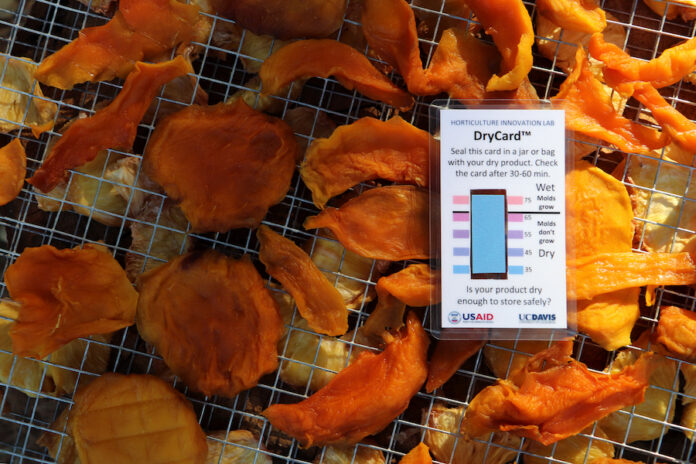UC Davis Horticulture Innovation Lab’s DryCard improves the health of communities by testing the dryness of grains, seeds.
Across several low-income and moderate-income countries, ambient humidity poses a challenge for food dehydration, a traditional method for food preservation. UC Davis agricultural engineers aim to change this paradigm, offering DryCard to test the dryness of products from the beginning of food production until they reach consumers.
When seeds and grains are not dried properly or are stored in a humid environment, they retain humidity and leave room for mold growth. Aspergillus flavus, a common mold, produces aflatoxin, which has been implicated in liver cancer and physical and intellectual stunting.
“4.5 billion of the world’s population live with aflatoxin in their food because of inadequate food storage for dehydrated foods,” said Kent Bradford, the director of the UC Davis Seed Biotechnology Center and professor in the UC Davis Department of Plant Sciences.
Aflatoxin exposure guidelines vary across countries.
“In India, 40 percent of grain becomes contaminated with aflatoxin above the United States’ 5 parts per billion threshold,” said Michael Reid, an professor emeritus in the UC Davis Department of Plant Sciences. “16 percent of the grain reaches above the Indian 30 parts per billion threshold. The United Nations’ aflatoxin guideline is 15 parts per billion.”
DryCard consists of laminated, business card-sized humidity cards that contain cobalt chloride. The card changes color from pink to blue based on a humidity index. Blue indicates 35 percent humidity, conditions in which it is unlikely for mold to grow and produce aflatoxin. The color scales up to pink, indicating the 65 percent humidity threshold has been surpassed and there is the risk of mold contamination.
“Based on the concept of water activity, if the headspace humidity above a product is less than 65 percent, molds won’t grow,” said James Thompson, an emeritus extension engineer in Biological and Agricultural Development in the UC Davis Horticulture Innovation Lab. “It works across everything, fruits, grains, paper or any biological material.”
DryCard can be applied to any grown material requiring dehydration after harvest.
Growers place a DryCard into a sample of produce. The card changes color based on humidity retained in the product, allowing farmers to make informed decisions based on whether their dry products have lost enough humidity. They can either sell safely dried products to consumers or dehydrate them once again.
Reid got the idea for DryCard from his agricultural extension class in Tanzania.
“I knew my students could tell the water content in grains by using cobalt chloride strips I brought from the United States,” Reid said. “I sent one student to the local market to buy dried grains for us to sample in the class using the strips. We sampled them. My students were surprised about the high water content in the dried foods from their local markets.”
The relative humidity indicator paper with cobalt chloride was originally invented in 1950 to measure humidity in hard-to-reach spaces.
Now, the concept is being applied to traders, consumers, rural and local farmers and agricultural businesses across the world, managing their production and health safety.
Potential partners are recruited or contact the Horticulture Innovation Lab, submitting a business proposal and community engagement strategies for review by the lab.
“Our role is to send our partners a starter package to begin DryCard production,” said Anthony Phan, the project analyst for the UC Davis Feed the Future Horticulture Innovation Lab. “We send them all the materials they need to produce 10,000 DryCards, specifications and resources to become local DryCard experts. Once they can produce 10,000, they become self-sustainable, able to buy their own materials and lead awareness efforts for rural farmers.”
The Horticulture and Innovation Lab currently partners with eight businesses across several countries, including Mexico, Thailand, Rwanda and Tanzania, assembling a DryCard consortium for businesses to collaborate and exchange ideas.
The UC Davis Seed Biotechnology Center’s Seed Production three-day course spotlighted agricultural and biological seed production and processing practices, encouraging businesses to consider applying DryCard among other technologies to their current agricultural practices.
Suhas Barge, a production general manager at Kalash Seeds based in India, is eager to incorporate DryCard into onion seed production, leaving the Seed Production course with DryCard samples to test seed dryness across production and storage with local farmers.
“We, [Kalash Seeds], produce 300 metric tons of dry onion seeds with 2,000 individual growers,” Barge said. “If we have moisture in our products, it’s a big loss for our business and consumers.”
DryCard has met challenges in adapting behavior to accept new drying technologies.
“These farmers have been drying for ages, they rely on ancient practices, usually they will bite, crunch or just look at food products to know that they are dry,” Phan said. “It’s hard to get them to know that food loss, short food life and mold contamination can be attributed to these practices.”
The DryCard aims to meet this challenge by partnering with distributors who are well-known, respected community members. They can create culturally-sensitive DryCards and agricultural education to build community-driven businesses to reshape local agriculture, careers and health.
“People put a lot of effort into drying, but their packaging often is porous or stored in a humid environment, which leads to seed death,” Bradford said. “Moisture combined with either a low or high-temperature environment kills seeds. They will have low shelf-lives. You can put DryCard with plastic seed storage containers and when you look at the DryCard through the container, you can tell whether you need to dry the seeds again.”
Written by: Foxy Robinson — science@theaggie.org




